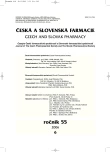Measurement of Adhesive Properties of Polymers in vitro
Měření adhezivních vlastností polymerů in vitro
Byla studována adhezivita větvených oligoesterů v podmínkách in vitro měřením maximální síly potřebné k odtržení testovaného vzorku od podkladu (Fmax) za různých testovacích podmínek. Větvené oligoestery byly syntetizovány z kyseliny mléčné a glykolové v molárním poměru 1 : 1 a mannitolu nebo dipentaerythritolu jako větvící složky v koncentraci 3 %, 5 % nebo 8 %. Pro snížení viskozity, a tím usnadnění zpracovatelnosti a aplikace byl použit triethyl–citrát (TEC) v koncentraci 30 %. Polymerní systémy pro měření adhezivity byly připraveny tavením oligoesterů v mikrovlnné troubě a důkladnou homogenizací s TEC. Adhezivní síla byla měřena na materiálovém zkušebním stroji T1-FR050TH.A1K Zwick/Roell při nastavené rychlosti odtržení 10 mm/min nebo 100 mm/min, kontaktní síle 10 N nebo 20 N a době kontaktu vzorku s podkladem 5 s nebo 10 s. Bylo zjištěno, že adhezivita větvených oligoesterů je významně vyšší než adhezivita gelů želatiny, methylcelulosy, karmelosy sodné soli nebo karbomeru sodné soli. Oligoestery větvené dipentaerythritolem vykazovaly vyšší adhezivní sílu než oligoestery větvené mannitolem. S rostoucí koncentrací větvící složky v oligoesteru se zvyšovala hodnota adhezivní síly. Z testovaných zkušebních parametrů byl zjištěn statisticky významný vliv rychlosti odtržení vzorku od podkladu na velikost Fmax. Vliv různé doby kontaktu se projevil pouze u některých vzorků a vliv různé kontaktní síly na hodnotu Fmax nebyl prokázán u žádného vzorku.
Klíčová slova:
bioadheze – in vitro testy – větvené oligoestery
Authors:
E. Šnejdrová; M. Dittrich
Authors‘ workplace:
Univerzita Karlova v Praze, Farmaceutická fakulta v Hradci Králové, Katedra farmaceutické technologie
Published in:
Čes. slov. Farm., 2006; 55, 262-266
Category:
Original Articles
Overview
Adhesive force of branched oligoesters under the in vitro conditions was studied by measuring the maximal force necessary to separate the tested sample from the base (Fmax) under different testing conditions. Branched oligoesters were synthesized from lactic and glycolic acids in the molar ratio 1 : 1, and from mannitol or dipentaery thritol as the branching components in concentrations of 3%, 5% or 8%. To decrease viscosity and thus to facilitate the workability and administration, triethyl citrate (TEC) in a concentration of 30% was employed. Polymeric systems for adhesive force measurements were prepared by melting oligoesters in a micro oven and by homogenization with TEC. Adhesive force was measured on a material testing device T1-FR050TH.A1K Zwick/Roell at the set rate of separation 10 mm/min or 100 mm/min, contact force 10 N or 20 N, and a period of contact of the sample with the base of 5 s or 10 s. The adhesive force of branched oligoesters was found to be significantly higher than the adhesive force of gelatine gels, methylcellulose, carmelose sodium salt or sodium carbomer salt. Dipentaerythritol-branched oligoesters exerted higher adhesive force than mannitol-branched oligoesters. The value of adhesive force was increased with growing concentration of the branching component in the oligoester. Of the experimental parameters tested, a statistically significant influence of the separation rate of the sample from the base on the magnitude of Fmax was observed. The influence of different periods of contacts was manifested only in some samples, and the influence of different contact forces on Fmax value was not demonstrated in any sample.
Key words:
bioadhesion – in vitro tests – branched oligoesters
Labels
Pharmacy Clinical pharmacologyArticle was published in
Czech and Slovak Pharmacy

2006 Issue 6
Most read in this issue
- Liquid Ginger Extract: Technology of Production and Quality Evaluation
- University Courses in Pharmacy in the Czech Republic
- Measurement of Adhesive Properties of Polymers in vitro
- Potentiometric Determination of Aqueous Dissociation Constants of 2-,3-,4-{3-(4-Benzhydryl-piperazine- -1-yl)-2-hydroxy-propoxy}-phenylcarbamic Acid Alkylesters, Water Insoluble Potential Blockers of ß-Adrenergic Receptors
